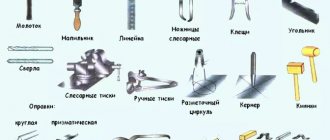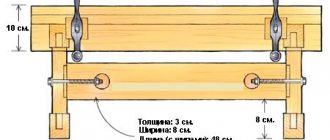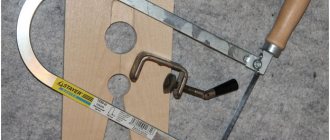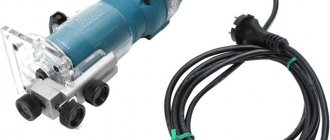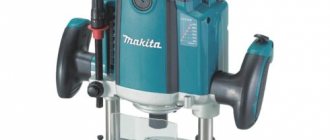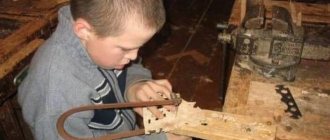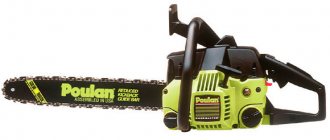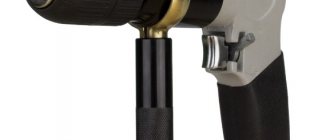In our age of dominance of various electric tools, a mechanical drill has been forgotten by everyone. Only a few of the masters of the old generation have preserved rarities: in their workshops, hand-held devices of various models are kept in a place of honor - greetings from the last century from the USSR. However, mechanical hand drills remain the most economical, practical and autonomous, compared to their descendants - electric models. You can work with a hand drill anywhere, even on a remote hunting ground in the taiga; they only require skilled hands.
Advantages of mechanical tools
The main advantage of a hand drill is its simple design and the unique reliability of all parts made of very durable metals. It is quite difficult to break something in this design, which is why it differs from the electric model. There are many examples of such a product serving well for several generations of craftsmen.
It is a hand drill that does an excellent job of drilling in such delicate materials as drywall, fiberboard, fragile plastic, various types of wood and plywood. It can be used on the roof or attic because it does not require an electrical connection.
This simple tool has excellent performance when tightening and unscrewing various threaded fasteners: screws, self-tapping screws, screws - you just need to insert the appropriate bit into the chuck. An advantage of the device is the low cost of such a tool: no more than 1 thousand rubles, making a hand drill accessible to all segments of the population.
In medicine, a hand drill is widely used for specific processing of bones and installation of knitting needles in them - model DR-2.
pros
There are a sufficient number of advantages that fully justify the use of the described tools.
- Simplicity of design. Due to the absence of a large number of components, mechanical drills are easily repaired and do not require particularly careful maintenance. This allows you to significantly reduce the amount of time and money required to ensure the functionality of the tool used. The solution to this problem is not difficult: it involves timely application of lubricants and replacement of parts that have exhausted their working life.
- Reliability and durability. Experience shows that it is very difficult to break a hand drill even with regular and very intensive use. This is due to the high quality of the materials used in the manufacture of such instruments (especially those produced during the Soviet era). Many mechanical drills produced several decades ago still serve successfully, having repeatedly justified their original cost.
- Autonomy. The described tools do not require electrical power, and therefore they can be used anywhere. This advantage of hand drills is especially important for those who have to work far from the usual benefits of civilization.
- Reasonable price. Today, a new hand drill can be purchased for 600-1000 rubles, while a used mechanical “assistant” will cost even less (about half). In addition to the technical condition, the cost of the instrument is influenced by its dimensions, equipment, body material and the reputation of the manufacturer.
Read also: How to replace the plug on an Internet cable yourself
Most often, craftsmen give preference to two-handed drills, using them to create small holes and grooves. Accurate performance of such work requires precise adjustment of the drilling depth and extremely careful rotation, for which the described tool is most suitable.
Types of designs
Experts divide mechanical drills into two main types.
- Product with one rotation speed.
- Manual two-speed design with a special gearbox.
Developers from different countries have been struggling with the problem for a long time: how to make a simple hand drill work at two speeds. For these purposes, a two-stage multiplier was invented - a gearbox of an original design, which has a set of gears arranged on different axes in a single housing.
To switch the drilling speed, you need to move the rotation handle to the other side. The gear ratio of the gearbox increases or decreases, and the number of revolutions of the cartridge per rotation of the handle changes accordingly.
Models are produced where there is no need to move the handle - the speed is switched as a result of the longitudinal displacement of the axis of rotation of the handle.
The main difference between this model is the gearbox: it is closed and located in a special housing, but, as in the first option, it can be easily disassembled, all parts are accessible for cleaning and lubrication.
The figure below shows a two-handed version of a hand drill:
The ancient progenitor - the bracelet
The rotator, an analogue of a hand drill, which was invented by our distant ancestors, is not outdated, it is too early to write it off. It can be useful for unscrewing a “recalcitrant” screw or a stuck screw. To do this, you just need to sacrifice the old screwdriver and use muscle force.
The design of the rotor is extremely simple. It consists of two parts: a frame and a simple device for attaching a drill (chuck). In the picture below you see a wonderful example of Soviet industry for domestic use. The frame is specially bent and forms an incomplete rectangle; on the side there is a rotating handle, with the help of which the entire structure rotates smoothly around its axis.
Pressure is applied to the upper hemispherical handle; it also rotates freely without interfering with drilling. The same principle applies to a drill for drilling holes for winter fishing or holes for seedlings in a garden plot, which you can construct with your own hands. You can learn how to make a simple bracelet, for example, from this video:
Today's Tool Accessories
After some time…
...a conventional drill with an electric motor has been modernized and additional “gadgets” have appeared: the ability to drill with impact, reverse, the presence of an electric speed controller, LED backlighting, torque control, etc.
There are also cordless drill models that work autonomously and do not depend on an electrical source; Angle drills have also appeared, which will become an indispensable assistant for working in hard-to-reach places or where space is limited.
Home crafts
At home, you can make a simple hand drill with your own hands from improvised means, designs and variations. We will provide several links to videos that show in detail how to make original designs.
- Drill based on mini motors:
- A mini-machine into which dental burs are inserted to make inscriptions on various surfaces at home:
- Mini-machine for polishing jewelry based on an old drill.
Safety and nuances when choosing
Before choosing a mechanical drill, special attention must be paid to the quality of manufacture of all visible parts, the smooth rotation of the chuck, and the comfort of the handles. There are no burrs, sharp edges or edges allowed on the housing; the gears inside the gearbox must rotate without extraneous noise.
A mechanical simple hand drill does not require any special skills to use. But there are safety requirements that are designed to minimize the possibility of injury to the worker and damage to the tool.
- Any workpiece to be drilled must be firmly fixed. If you hold it with your hands, it may break out and cause injury.
- Do not touch the drill with your hands - as a result of friction, it becomes very hot, especially in cases where metal is drilled.
- When drilling at high speeds, you need to take breaks to allow the drill to cool or apply a cooling suspension to it.
- Protect your hands with gloves and your eyes with goggles, because small drilling waste can cause injury, although the speed is not so great.
Safety measures have been developed over many years based on the analysis of incidents during work and take into account the most negative cases from practice.
Hand drill: how useful is this tool?
Today, such an indispensable tool from the times of the USSR, like a hand drill, is increasingly forgotten. This is explained by its replacement with electric drills, which have a number of undeniable advantages.
However, despite the fact that the hand drill has long faded into the background and even the third place, many craftsmen can still find it in their arsenal.
Why a hand drill is needed, as well as its advantages over a power tool, we will consider further.
Application area
Hand drills are also called rotary drills or mechanical drills. During the Soviet era, such a device was an indispensable tool not only for repair work, but also for the household in general. Previously, such a drill was called a rotary drill, since it was structurally a curved frame with a chuck for securing drills.
The improvement of the rotator led to the creation of a hand drill, structurally consisting of a chuck, a handle, and also a gearbox with gears.
During the USSR, such devices were used to carry out a number of different works.
Today, power tools are used for such work, but there are still areas where hand-held devices still continue to be popular.
A hand drill allows you to drill holes in wood, concrete, metal and other materials. The only drawback is the need to rotate the cartridge manually, through a gearbox. Today, such products have found their application in screwing screws.
Electric screwdrivers can handle this task quickly and easily, but very often there are times when the power of the power tool is simply not enough to screw the screw in completely.
A hand drill comes to the rescue, the screwing force of which directly depends on the physical condition of the person.
As before, today, in medicine, a hand drill is the most necessary tool, which is intended for drilling bones, which is done to be able to install knitting needles in them for fusion. In addition, mechanical tools have found their application for marking.
To apply markings, various tools can be used, including a brace.
In addition, with the help of a mechanical tool, existing holes are drilled, countersinked, and even reamed, so you should not rush to throw away such a useful type of tool.
Pros and cons of such a drill
Like a power tool, a hand drill also has its advantages and disadvantages. First, let's list the advantages:
- Simplicity of design. The simplest design of the tool makes it possible to reduce the cost of the tool and also increase reliability. Modern manual units are made from materials that are not as high quality as in Soviet times. But nevertheless, such a product is difficult to break, and even if any breakdown occurs, it can be fixed quite easily, quickly and independently.
- No need to connect to electricity. The tool can be used in the field, which increases the functionality of the device.
- Low cost. Today you can buy a new mechanical drill for a maximum of 1000 rubles, but outdated models are more popular, which can be purchased from 400 rubles.
As for the disadvantages, the device in question also has them. These include:
- The need for physical force. Sometimes this property is very useful, as it allows you to pump up your muscles.
- Large dimensions of the product. Despite the simplicity of the design, the product is larger than power tools, which makes it difficult to transport.
- Heavy weight of some models. The weight of the tool depends on the materials from which the device parts are made. If cast iron is used, the weight of the tool reaches 2-3 kg.
What is
A hand drill and a brace have slightly different designs, but the end result is the same. The rotational moment of the rotary chuck directly depends on the number of rotational movements by a person. Hand drills come in single-speed and two-speed types.
A two-speed hand drill is equipped with four gears, through which the torque is increased when a force of the same magnitude is applied. This property allows you to regulate the speed of drilling holes, increasing it by 2-4 times compared to a rotary hammer. To regulate the speed, you simply need to change the drive shaft on which the handle is fixed.
Single-speed drills are a simplified version, since they have 2 gears, one of which (large diameter) is driving, and the second is driven. In such tools, the rotation speed of the chuck can only be adjusted manually.
Structurally, a hand tool is:
- from two to four gears depending on the type of tool;
- a handle that connects to the drive gear shaft;
- a cartridge presented in the form of a collet mechanism;
- additional handle for holding the device;
- emphasis
The operating principle of a hand drill is quite simple. The drive gear, which is several times larger in size than the driven one, is driven by the handle. The different number of teeth on the drive and driven gears allows you to vary the torque. The transmission torque ensures the rotation of the driven gear, which is rigidly connected to the tool chuck.
Working with a hand drill
When working with a mechanical hand drill, it is important to follow safety rules when working. Such a tool is less dangerous than its electric counterparts, but, nevertheless, it can cause irreparable damage to health. When working with the device in question, it is important to follow the following recommendations:
- The part that is being drilled or into which the fastener is screwed must be securely fastened, otherwise you may cause damage to yourself.
- The drill, as with power tools, tends to heat up when drilling, so do not rush to pick it up after finishing the work.
- It is important to allow the drill bit to cool while drilling, as excessive heat can cause dullness and damage.
- It is important to wear safety glasses and gloves when working with the tool.
Following simple safety rules when working with a hand drill will help prevent serious injuries and damage.
Hand drill: how useful is this tool Link to main publication
Source: https://InstrumentyvDom.ru/ruchnoj/ruchnaya-drel-poleznyj-instrument

